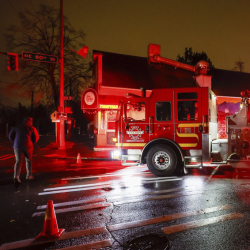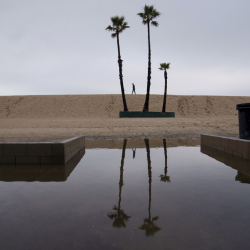 BU MARIEM, Libya (AP) -- An American fighter jet crashed in Libya's rebel held east, both crew ejecting safely as the aircraft spun from the sky during the third night of the U.S. and European air campaign. Moammar Gadhafi's forces shelled rebels regrouping in the dunes outside a key eastern city on Tuesday, and his snipers and tanks roamed the last major opposition-held city in the west.
BU MARIEM, Libya (AP) -- An American fighter jet crashed in Libya's rebel held east, both crew ejecting safely as the aircraft spun from the sky during the third night of the U.S. and European air campaign. Moammar Gadhafi's forces shelled rebels regrouping in the dunes outside a key eastern city on Tuesday, and his snipers and tanks roamed the last major opposition-held city in the west.
The Skanner News Video: Crashed U.S. Jet
The crash was the first major loss for the U.S. and European military air campaign, which over three nights appears to have hobbled Gadhafi's air defenses and artillery and rescued the rebels from what appeared to be imminent defeat. But the opposition force, with more enthusiasm than discipline, has struggled to exploit the gains. The international alliance, too, has shown fractures as officials struggle to articulate an endgame.
China and Russia, which abstained from the U.N. Security Council vote authorizing the international intervention, called for a cease-fire Tuesday from international forces.
The U.S. Air Force F-15E came down in field of winter wheat and thistles outside the town of Bu Mariem, about 24 miles (38 kilometers) east of the rebel capital of Benghazi.
By Tuesday afternoon, the plane's body was mostly burned to ash, with only the wings and tail fins intact. U.S. officials say both crewmembers were safe in American hands.
"I saw the plane spinning round and round as it came down," said Mahdi Amrani, who rushed to the crash site with other villagers. "It was in flames. They died away, then it burst in to flames again."
The U.S. Africa Command said both crewmembers were in American hands with minor injuries after what was believed to be a mechanical failure of the on Monday night. One was picked up by a rebel force and the other by a Marine Corps Osprey search and rescue aircraft.
Most of eastern Libya, where the plane crashed, is in rebel hands but the force has struggled to take advantage of the gains from the international air campaign.
Ajdabiya, city of 140,000 that is the gateway to the east, has been under siege for a week. Outside the city, a ragtag band of hundreds of fighters milled about on Tuesday, clutching mortars, grenades and assault rifles. Some wore khaki fatigues. One man sported a bright white studded belt.
Some men clambered up power lines in the rolling sand dunes of the desert, squinting as they tried to see Gadhafi's forces inside the city. The group periodically came under artillery attacks, some men scattering and others holding their ground.
"Gadhafi is killing civilians inside Ajdabiya," said Khaled Hamid, a rebel who said he been in Gadhafi's forces but defected to the rebels. "Today we will enter Ajdabiya, God willing."
Since the uprising began on Feb. 15, the opposition has been made up of disparate groups even as it took control of the entire east of the country. Regular army units that joined the rebellion have proven stronger and more organized, but only a few units have joined the battles while many have stayed behind as officers try to coordinate a force with often antiquated, limited equipment.
The rebels pushed into the west of the country in recent weeks, only to fall back to their eastern strongholds in the face of Gadhafi's superior firepower.
Misrata, Libya's third-largest city and the last major western redoubt for the rebels, was being bombarded by Gadhafi's forces on Tuesday, his tanks and snipers controlling the streets, according to a doctor there who said civilians were surviving on dwindling supplies of food and water, desperately in search of shelter.
Speaking on condition of anonymity for fear of reprisals if the city falls to Gadhafi's troops, he accused international forces of failing to protect civilians as promised under the United Nations resolution authorizing military action in Libya.
"Snipers are everywhere in Misrata, shooting anyone who walks by while the world is still watching," he said. "The situation is going from bad to worse. We can do nothing but wait. Sometimes we depend on one meal per day."
Mokhtar Ali, a Libyan dissident in exile elsewhere in the Mideast, said he was in touch with his father in Misrata and described increasingly dire conditions.
"Residents live on canned food and rainwater tanks," Ali said. He said Gadhafi's brigades storm residential areas knowing that they won't be bombed there. "People live in total darkness in terms of communications and electricity."
Monday night, Libyan state TV said a new round of strikes had begun in the capital, Tripoli, marking the third night of bombardment. But while the airstrikes can stop Gadhafi's troops from attacking rebel cities - in line with the U.N. mandate to protect civilians - the United States, at least, appeared deeply reluctant to go beyond that toward actively helping the rebel cause to oust the Libyan leader.
U.S. Defense Secretary Robert Gates and others said the U.S. military's role will lessen in coming days as other countries take on more missions and the need declines for large-scale offensive action like the barrage of Tomahawk cruise missiles fired mainly by U.S. ships and submarines off Libya's coast.
A senior defense official, speaking on condition of anonymity to discuss classified data, said Monday that the attacks thus far had reduced Libya's air defense capabilities by more than 50 percent. That has enabled the coalition to focus more on extending the no-fly zone, which is now mainly over the coastal waters off Libya and around the rebel stronghold of Benghazi in the east, across the country to the Tripoli area this week.
In his first public comments on the crisis, Army Gen. Carter Ham, the lead U.S. commander, said it was possible that Gadhafi might retain power.
"I don't think anyone would say that is ideal," the general said Monday, foreseeing a possible outcome that stands in contrast to President Barack Obama's declaration that Gadhafi must go.
The Libyan leader has ruled the North African nation for more than four decades and was a target of American air attacks in 1986.
Portland and Seattle
Free Subscription to Breaking News
Free Subscription to Breaking News





















































































































































































































































































































































